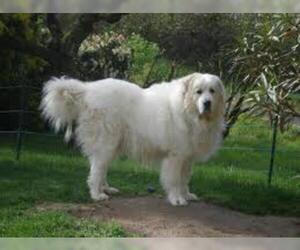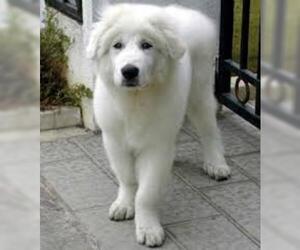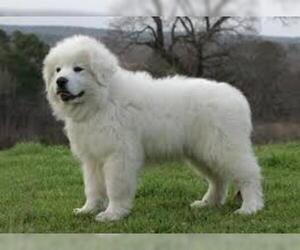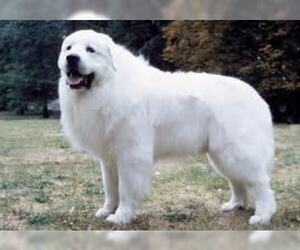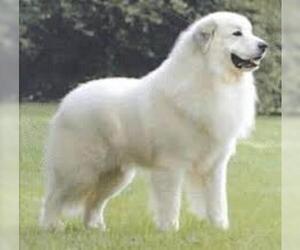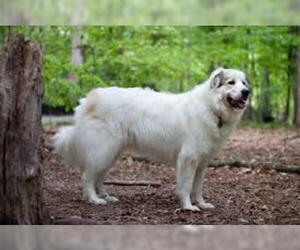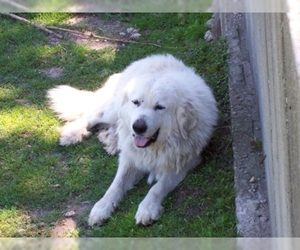
All about Great Pyrenees dog breed
A.K.A. :Pyrenean Mountain Dog, Patou, Chien de Montagne des Pyrénées, Pyrenean, Big White Dog, Bear Dog, Gentle Giant, Great Pyr, Pyr
Size
Grooming requirements
Exercise requirements
Good with other dogs
Watchdog ability
Energetic
Training requirements
Playful
Affectionate
Good with other pets
Good with children
Good with strangers
Winter
Summer
Healthiness
Protective
Life Span
| Pure Breeds | Member |
| Breeds A - Z | G |
| Breeds by Group | Flock Guards & Mastiffs Working |
| Breeds by Trait | Good With Kids Low Shedding |
| Overview: | The Great Pyrenees is a majestic and ancient breed, originating in the Pyrenean mountains between France and Spain, where they served as formidable livestock guardians. Physically, they are large, powerful dogs, easily recognized by their thick, double coat, typically white (though sometimes marked with badger, grey, or tan), and a distinctive "double dewclaw" on their hind legs. Despite their imposing size, their temperament is generally calm, gentle, and remarkably patient, making them excellent companions. They possess a natural protectiveness, which translates to a watchful eye over their families and property. While loving and tolerant with children, their size and barking tendencies make them less suited for small apartment living; a home with a yard is ideal. Prospective owners should be aware of common health concerns such as hip and elbow dysplasia, patellar luxation, and certain eye conditions, emphasizing the importance of responsible breeding. Their independent nature also means they require consistent, positive reinforcement training. |
F.A.Q.
All You Need to Know About the Great Pyrenees Breed
The Great Pyrenees is a majestic guardian breed, originating from the Pyrenees mountains between France and Spain, where they protected livestock. Known for their calm, gentle, and patient temperament, they are excellent family dogs, often forming strong bonds with children. Physically, they boast a thick, weather-resistant white coat, powerful build, and an intelligent, watchful expression. While affectionate, their independent nature means early socialization and training are crucial. They are not ideal for apartment living due to their size and need for space, thriving best in homes with a securely fenced yard. Grooming requires regular brushing to manage shedding, and their exercise needs are moderate, enjoying daily walks or yard play. Common health considerations include hip and elbow dysplasia and bloat, making responsible breeder selection important for this loyal and protective companion.Great Pyrenees Weight: The average healthy weight for adult Great Pyrenees typically ranges from 85 to 115 pounds. Males tend to be larger, weighing between 100-115 pounds, while females usually fall within 85-100 pounds. This is the typical size for a healthy adult Great Pyrenees, ensuring they are not overweight or underweight for the breed.
How Tall is a Great Pyrenees? Understanding Their Average Height
The average height of a Great Pyrenees is quite impressive, reflecting their majestic and powerful build. When considering Great Pyrenees height, it's important to measure them at the shoulder (the highest point of the shoulder blades).Typically, adult Great Pyrenees stand at:* Males: 27 to 32 inches tall at the shoulder.* Females: 25 to 29 inches tall at the shoulder.This means the overall average size for a Great Pyrenees generally falls between 25 to 32 inches at the shoulder.You'll notice a slight variation, with males often being a bit taller and more substantial than females. However, individual genetics and nutrition can also play a role, meaning some Great Pyrenees may fall slightly outside these ranges. Rest assured, whether on the higher or lower end of this spectrum, a Great Pyrenees will always be a large and imposing dog!The Great Pyrenees colors primarily consist of white or cream, often with markings of badger, gray, or various shades of tan. The AKC recognized Great Pyrenees colors are white, cream, tan, and reddish-brown (badger). These markings can appear on the head, ears, and tail.While the standard for the breed dictates these classic colors, rare coat types and exotic Great Pyrenees variations have occasionally appeared due to genetic mutations or outcrossing, though they are not accepted by major kennel clubs like the AKC. These can include, but are not limited to, brindle Great Pyrenees, fawn Great Pyrenees, blue Great Pyrenees, lilac Great Pyrenees, merle Great Pyrenees, and chocolate Great Pyrenees. These rare Great Pyrenees colors are highly unusual and typically indicate a non-standard lineage, often impacting pricing due to their novelty rather than breed adherence. Potential buyers should be aware that such variations are not true to the breed standard and are often a result of mixed parentage. Always prioritize a breeder who adheres to the official breed standard for health and temperament.
The Great Pyrenees possesses a gentle, devoted, and protective temperament. Known for their calm and patient Great Pyrenees personality, they are exceptionally loyal to their families. While generally friendly with their loved ones, they can be somewhat reserved with strangers, a natural extension of their guardian instincts. Their temperament of Great Pyrenees is one of quiet strength and independence, making them excellent companions for those who appreciate a thoughtful and steadfast presence.Sociability: They typically get along well with respectful children, often displaying a patient and tolerant demeanor. With proper introduction and socialization, they can also coexist harmoniously with other pets.Adaptability to Apartment Living: Due to their large size and need for moderate exercise, Great Pyrenees are generally not well-suited for apartment living. They thrive in homes with a secure yard where they can patrol and feel like they have a job. While not high-energy, they do enjoy leisurely walks and having space to stretch out. Their natural instinct is to guard a territory, and a small enclosed space can lead to boredom and potential behavioral issues.
Great Pyrenees Temperament: A Gentle Giant's DispositionThe Great Pyrenees temperament is renowned for its calm, gentle, and patient nature, making them excellent companion dogs. They are highly loyal and protective of their families, often forming strong bonds. Generally friendly and sociable, they are usually good with respectful children, often displaying a watchful and tolerant demeanor. With proper socialization, they can coexist peacefully with other pets, though their natural guarding instinct might lead them to be initially reserved with strangers.While possessing a sweet disposition, the Great Pyrenees can exhibit a degree of independence and stubbornness, a remnant of their livestock guarding heritage. This means they respond best to positive reinforcement and consistent training. They are intelligent but can be sensitive, so harsh corrections should be avoided. Due to their size and need for a view, they are generally not well-suited for apartment living, preferring homes with a secure yard to patrol and observe. Their protective instincts mean they will often bark at perceived threats or anything out of the ordinary in their territory. Overall, their personality traits lean towards a devoted, watchful, and affectionate family member who thrives in a loving and understanding environment.
Great Pyrenees Care: Your gentle giant needs specific care. Grooming is essential due to their thick double coat. Expect significant shedding, requiring regular brushing (2-3 times weekly, daily during shedding seasons) to prevent mats and maintain skin health. While low-energy dog breed, they still benefit from moderate daily exercise like walks or yard play; avoid strenuous activity. Dietary considerations involve high-quality dog food appropriate for large breeds, with careful portion control to prevent weight management issues. Wrinkle and ear cleaning are NOT typically concerns for the Great Pyrenees as they lack wrinkles and have drop ears that are generally self-cleaning, though occasional ear checks are wise. Climate sensitivity is minimal for the Great Pyrenees; they are well-adapted to colder climates due to their coat. However, they can overheat in very hot weather, so provide shade and water. Common health tips for Great Pyrenees include monitoring for hip and elbow dysplasia, bloat, and eye conditions. Regular vet check-ups are crucial for early detection and dental care. Skin issues are uncommon but can arise from poor grooming. This concise guide covers how to care for a Great Pyrenees for potential owners.
The Great Pyrenees activity level is generally moderate to low. While they are large dogs, how active are Great Pyrenees typically depends on their age and individual personality.Energy Levels: Great Pyrenees are known for their calm and watchful nature. They possess short bursts of energy for patrolling their territory or playing, but are equally content with long periods of rest and observation. They are not a hyperactive breed and often prefer a more relaxed pace.Daily Exercise Needs: Despite their size, their exercise needs are surprisingly manageable. A minimum of 30-60 minutes of moderate daily exercise is usually sufficient. This can include a leisurely walk, supervised playtime in a securely fenced yard, or a short hike. While they can be athletic, they are not built for endurance running or intensive, high-impact activities for extended periods.Playtime Preferences: They enjoy interactive playtime with their family, especially activities that involve gentle tugging, chasing a ball for short distances, or exploring new scents on a walk. Their guardian instincts mean they often enjoy surveying their surroundings from a comfortable spot.Brachycephalic Limitations: It's important to note that Great Pyrenees can be sensitive to heat due to their thick double coat. While not truly brachycephalic (short-nosed), their larger size and potential for thicker muzzles mean they can overheat more easily than breeds with longer snouts. Therefore, strenuous exercise during hot weather should be avoided, and walks should be scheduled during cooler parts of the day.Suitability: The Great Pyrenees is an excellent choice for low-energy households or families seeking a calm, watchful companion. They are generally not suitable for highly active families looking for a jogging or intense hiking partner due to their more relaxed nature and heat sensitivity. Their balanced energy allows them to adapt well to various home environments, provided their basic exercise needs are met and they have ample space to stretch out.
Breed Breakdown: What Experts Say About the Great Pyrenees
I would rate the "Size" trait of the Great Pyrenees as a 9 out of 10.This breed is undeniably very large. Male Great Pyrenees typically stand 27-32 inches tall at the shoulder and weigh 100-160 pounds, while females are slightly smaller but still substantial at 25-29 inches and 85-115 pounds. Their body structure is powerful and heavily boned, giving them a commanding presence. When compared to most other companion dog breeds, the Great Pyrenees easily falls into the giant category, far exceeding the dimensions of popular breeds like Golden Retrievers, Labradors, or German Shepherds. This impressive size means they are definitely not well-suited for apartment living or households with significant space constraints. Their large stature also makes them less convenient for frequent travel, as they require ample room in vehicles and often face airline restrictions. They thrive in homes with large yards and plenty of indoor space to stretch out.
I would rate the Great Pyrenees' "Grooming Requirements" at a 7 out of 10.While they don't necessarily require highly specialized professional grooming tools or techniques for their fur, their thick double coat and significant shedding frequency push them firmly into the higher-maintenance category compared to many other companion dogs. They are not easy to care for in terms of grooming. Their dense undercoat needs regular and thorough brushing, ideally several times a week, to prevent matting and manage the copious amounts of hair they shed, especially during seasonal blow-outs. This shedding is considerable and will be a constant presence in the home. While they generally have healthy skin and are not prone to excessive skin folds or allergies, their ears do need routine checking and cleaning to prevent infections due to their drop ear type. Nail trimming is essential and needs to be done regularly due to their size and activity level. Bathing is less frequent than some breeds, perhaps every few months, but due to their size and coat density, it's a significant undertaking when it does occur, requiring thorough rinsing and drying to prevent skin issues. Therefore, while not requiring intricate styling, the sheer volume of coat, the constant shedding, and the necessary routine care for nails and ears make them a demanding breed in terms of grooming time and effort.
I would rate the Great Pyrenees' exercise requirements at a 3.While these majestic dogs are large and powerful, they are surprisingly low-energy when it comes to sustained physical activity. Their primary historical role as livestock guardians involved long periods of watchful observation, with bursts of speed and power only when absolutely necessary. This translates to a breed that thrives on minimal, yet consistent, daily activity. Short, leisurely walks of 20-30 minutes once or twice a day are typically sufficient to keep them healthy and mentally stimulated. They are not built for endurance and can overheat easily with vigorous or prolonged exercise, especially in warm weather. You won't find them excelling in agility or needing extensive running routines. Their mental stimulation often comes from surveying their surroundings and engaging in their natural guarding instincts, rather than needing complex training sessions or intense physical challenges. Too much high-impact exercise can actually be detrimental to their joints, particularly as puppies. They are content with a relaxed pace of life, making them suitable for owners who prefer less strenuous exercise routines.
I would rate the Great Pyrenees' "Watchdog Ability" as an 8 out of 10. They are incredibly alert and possess strong territorial instincts, making them highly vigilant. Their deep, resonant bark is a formidable deterrent, and they are quick to respond to unfamiliar sounds or people, usually with a sustained bark to announce the perceived threat. While they are known for their calm demeanor and can be gentle giants within their family, their primary historical role as livestock guardians has instilled in them a keen sense of protection. They are absolutely capable of providing meaningful early warnings in a home environment and will readily put themselves between their family and an intruder, often relying on their impressive size and intimidating bark to deter rather than engaging in aggressive physical confrontation. They are definitely not passive companions when it comes to home security.
I would rate the "Good with Other Dogs" trait of the Great Pyrenees breed a 6 out of 10.While Great Pyrenees are generally not an aggressive breed and can be quite tolerant, they are not inherently the most effusively "dog-friendly" either, especially with unfamiliar dogs. Their guardian instincts can lead them to be watchful and sometimes a bit reserved or aloof around new canine companions. They tend to be good at assessing situations and will usually avoid conflict rather than seeking it out.However, they can display a strong sense of personal space and, particularly unneutered males, may exhibit dominance towards other males, especially if they perceive a challenge. They thrive in households where they are socialized early and consistently with other dogs, and they can be wonderful companions in multi-dog households if introductions are managed and their individual personalities are respected. They often do well with dogs they've grown up with or those that respect their calm, sometimes stoic, demeanor. Their lower energy levels mean they are typically not a good match for high-energy play with all breeds, preferring a more sedate interaction. They require careful introductions to ensure peaceful coexistence, and while they can be very adaptable, it's not a trait that comes automatically; it's heavily influenced by their upbringing and continued socialization. They are generally compatible with dogs of different sizes, often tolerating smaller dogs well, as long as the smaller dog isn't overly boisterous or pushy.
I'd rate the "Energetic" trait of the Great Pyrenees as a 3 out of 10.The Great Pyrenees is a breed characterized by its laid-back and calm demeanor, especially compared to most other companion dogs. They are not naturally active and possess a relatively low typical activity level. While they enjoy a daily walk and some time to patrol their territory, their endurance for prolonged, strenuous activity is moderate at best. Playfulness is present, particularly in puppyhood, but as adults, it often manifests as a more sedate, interactive game rather than sustained, high-intensity play. Their need for physical stimulation is surprisingly low; mental stimulation through training and guarding duties is often more engaging for them than extensive exercise. They are generally not suited for participation in high-impact outdoor or athletic activities like agility or long-distance running.It's important to note that the Great Pyrenees is not a brachycephalic breed. They have a long, well-defined muzzle, which means their respiratory system is not inherently compromised in the way that it is in brachycephalic breeds. Therefore, their stamina and exercise tolerance are not negatively affected by brachycephalic anatomy. Their lower energy level is a result of their historical role as livestock guardians, which required watchful patience and bursts of defensive action, rather than sustained, high-speed movement. Their thick double coat also contributes to a tendency to overheat in warm weather, further limiting their suitability for intense, prolonged physical exertion.
I would rate the training requirements of the Great Pyrenees breed a 7 out of 10.While intelligent, the Great Pyrenees' training can be quite demanding due to their inherent independence and stubbornness. They possess a strong will and were historically bred to be self-sufficient guardians, making their attention span often focused on their perceived duty rather than human commands. Responsiveness to commands can vary greatly; they are not a breed that thrives on eager obedience. Consistency is absolutely paramount, and patience is a virtue when training a Pyr. Positive reinforcement is effective, but it needs to be delivered in a way that respects their independent nature and doesn't feel like coercion. This breed is generally not beginner-friendly and requires experienced handling and structured routines to establish clear boundaries and expectations. Owners must be prepared for a long-term commitment to training and socialization, understanding that a Pyr will always retain a degree of their independent spirit.
I'd rate the Great Pyrenees' "Playful" trait a 4 out of 10.While they can certainly enjoy a good romp, the Great Pyrenees is a naturally laid-back and dignified breed, far more suited to watchful guardianship than high-energy games. Their typical activity level is moderate at best, preferring to conserve energy for surveying their domain. They do appreciate a gentle game of fetch or a tug-of-war, especially with their beloved family, but these sessions are usually brief and less intense compared to more spirited companion dogs. They aren't typically attention-seeking through boisterous play, preferring calm affection or simply being in the same room. Their response to toys and playtime is generally positive but not overly enthusiastic; they might bat at a toy for a bit before settling down for a nap. Their overall enthusiasm in daily life leans towards a calm contentment rather than effervescent joy. They are content to observe and be present, making them wonderful, gentle companions, but not the go-to breed for endless, energetic play sessions.
I would rate the "Affectionate" trait of the Great Pyrenees at a 7. They are deeply loyal and form strong bonds with their families, showing a quiet devotion that is undeniably affectionate. They enjoy being in the same room as their people and will often follow family members around, acting as a gentle shadow. They are sensitive to owner emotions and will offer comforting nudges or lean into you when they sense distress. However, their affection often manifests as a calm, watchful presence rather than an overtly demonstrative one. While they appreciate gentle petting and are open to cuddles, they aren't typically "lap dogs" and generally aren't as physically demanding of attention as some other companion breeds. They value their independence and personal space to a degree, especially after a certain age, and aren't constantly seeking physical closeness. They thrive on affection in the sense of being part of the family and feeling loved, but they are more independently affectionate than breeds that truly *thrive* on constant physical interaction.
I would rate the "Good with Other Pets" trait of the Great Pyrenees breed a 7 out of 10.Great Pyrenees are generally known for their calm and gentle temperament, which extends to their interactions with other animals. They were historically bred to guard livestock, which instilled in them a protective instinct that often translates to a low prey drive towards animals they perceive as part of their "flock" – including household pets. They are often quite good with cats, frequently ignoring them or even engaging in gentle, if somewhat clumsy, interactions. With other dogs, especially those they are raised with, they tend to be tolerant and accepting.However, a rating of 7 rather than higher acknowledges a few important considerations. While their prey drive is generally low, it's not entirely absent, and an un-socialized Pyrenees or one with a stronger individual prey drive might still chase smaller, fleeing animals. Resource guarding, particularly of food or favored resting spots, can occur, especially if not managed through early training and consistent boundaries. While naturally sociable to a degree, proper socialization from a young age is crucial to ensure they learn appropriate interactions and boundaries with various types of pets. Without this, their protective instincts could manifest as a more dominant or territorial attitude towards new or unfamiliar animals. They are adaptable to multi-pet households, but their sheer size and powerful presence mean that even playful interactions can be overwhelming for smaller, more delicate pets, requiring owner supervision to prevent accidental injury. Therefore, while naturally inclined to be pet-friendly, they benefit greatly from proactive training and consistent supervision to truly thrive in a multi-pet environment.
I'd rate the Great Pyrenees' "Good with Children" trait a 9 out of 10.Great Pyrenees are generally exceptionally child-friendly, exhibiting a calm and patient temperament that makes them well-suited for families. They possess a natural gentleness and an inherent protective instinct towards their "flock," which often extends to the children in their family. Their large size might seem intimidating, but they are typically very aware of their surroundings and surprisingly gentle during interactions, often exhibiting a calm, slow demeanor around little ones. They have a high tolerance for noise and the sometimes clumsy handling of young children, rarely reacting with aggression. While they aren't typically high-energy and won't engage in endless games of fetch, they enjoy being near their family and observing the activity, occasionally engaging in a relaxed play session. While early socialization and consistent, positive reinforcement training are always beneficial for any dog, a Great Pyrenees is naturally inclined to be affectionate and tolerant, making them thrive in a family setting with minimal special training beyond basic obedience and supervision to ensure both dog and child are interacting safely and respectfully.
I'd rate the "Good with Strangers" trait of the Great Pyrenees an 8.While not universally leaping onto every new acquaintance like a Golden Retriever, the Great Pyrenees is generally very welcoming and tolerant of unfamiliar adults once they've been accepted into the home environment. Their protective instincts are primarily directed at perceived threats to their flock (family), not merely the presence of a new person. They are naturally calm and observant, often taking a moment to assess a newcomer before offering a gentle sniff or a relaxed lean. They don't typically bark excessively at guests unless there's a reason for alarm, and their guarding tendencies are more about presence and deterrence rather than overt aggression. Their adaptability in public or guest-filled environments is generally good, as their inherent placid nature allows them to handle new situations with composure. While early socialization is beneficial for any dog, a well-bred Great Pyrenees doesn't typically require extensive training to be comfortable with strangers; it's more about reinforcing their naturally gentle and accepting temperament. They are not naturally outgoing in a boisterous way, but rather in a dignified and quietly amiable manner.
The Great Pyrenees breed rates a 10 for "Winter" tolerance. Their exceptionally thick, double coat provides superior insulation against cold, snow, and ice, acting as a natural buffer. Their large size and substantial body fat further contribute to their ability to maintain core body temperature in frigid conditions. Unlike brachycephalic breeds, their long muzzle is well-suited for breathing in cold air without significant discomfort or risk of respiratory issues. These dogs were historically bred to guard livestock in the snowy Pyrenees mountains, a testament to their innate resilience. They possess an excellent ability to safely enjoy outdoor activities in very cold climates and are even known to thrive in such environments, often preferring to be outside in the cold rather than confined indoors. Compared to many other companion dog breeds, the Great Pyrenees generally requires little to no special care during winter months and in fact, their health and well-being often benefit from regular outdoor exposure in cold weather.
The Great Pyrenees breed rates a 3 for "Summer" tolerance. Their dense, double coat, while excellent for cold weather, makes them highly susceptible to overheating in warmer climates. They are a large breed, which also contributes to their difficulty in regulating body temperature. While not a brachycephalic breed, their heavy build and thick fur significantly increase their risk of heatstroke, even during moderate summer temperatures. Outdoor activity should be severely limited to early mornings or late evenings on warm days, and during peak heat, they require air-conditioned environments or at least shaded, cool indoor spaces with access to fresh, cool water. Compared to many other companion dogs, the Great Pyrenees absolutely requires special care in summer months, including proactive measures to keep them cool and vigilant monitoring for any signs of heat stress.
I would rate the Great Pyrenees' "Healthiness" trait as a 7 out of 10.While generally a robust and impressive breed, the Great Pyrenees isn't without its health considerations, preventing a perfect score. They are large breed dogs, which inherently predisposes them to certain orthopedic issues common in their size, such as hip and elbow dysplasia, as well as osteosarcoma (bone cancer). Gastric Dilatation-Volvulus (bloat) is another serious and life-threatening concern for deep-chested breeds like the Pyrenees. Eye conditions, including entropion and ectropion, are also seen. Their thick double coat, while beautiful, requires regular maintenance to prevent matting and potential skin issues, particularly in humid climates. Their average life expectancy of 10-12 years is respectable for a giant breed.However, with responsible breeding practices that include genetic screening for common inherited conditions and dedicated preventive care from owners – including a balanced diet, appropriate exercise to support joint health without overexertion, and regular veterinary check-ups – many Great Pyrenees live full and healthy lives. They are not typically considered high-maintenance in terms of needing constant medical intervention for breathing difficulties or delicate constitutions often seen in some brachycephalic or extremely delicate breeds. Instead, their "maintenance" leans more towards proactive care for their size and coat. Compared to some other companion dogs, they are generally robust, but their size does bring a specific set of potential health challenges that warrant careful attention.
I would rate the "Protective" trait of the Great Pyrenees breed a 9 out of 10.The Great Pyrenees were originally bred to guard livestock, and this inherent protective instinct translates powerfully to a household setting. They are incredibly alert, possessing a keen awareness of their surroundings and a low tolerance for anything they perceive as a threat to their "flock" (their family). Their territorial instincts are highly developed; they will patrol their designated space and actively deter intruders, often starting with a deep, authoritative bark that serves as a significant warning. Their loyalty to their owners is unwavering, forming a powerful bond that fuels their desire to keep them safe.Regarding strangers, they are typically reserved and watchful rather than immediately aggressive. They will assess the situation, often placing themselves between their family and the stranger. If the stranger poses no threat and is welcomed by theones they are protecting, they will generally accept them. However, if they perceive any suspicious behavior or intent, their protective instincts will kick in, becoming a formidable presence.While they are undoubtedly loving and gentle companion dogs to their families, the Great Pyrenees are absolutely capable of offering meaningful protection in a household setting. Their imposing size, deep bark, and resolute nature make them excellent watchdogs and can act as a significant deterrent. While they may not be the first breed you'd think of as an attack dog (their primary method is deterrence and intervention rather than unprovoked aggression), their sheer presence and willingness to stand their ground provide a powerful layer of security that far exceeds that of a typical companion animal. They are not merely "alert barkers"; they are serious guardians.
I would rate the "Life Span" trait of the Great Pyrenees breed a 6 out of 10.The Great Pyrenees, while majestic and generally robust, is considered to have an average to slightly below-average lifespan compared to many other companion dog breeds, especially smaller ones. Their typical life expectancy ranges from 10 to 12 years, which falls squarely into the mid-range for large and giant breeds. While some individuals certainly live longer, reaching 13 or 14 years, this isn't the common experience. Common health issues that can impact their longevity include hip and elbow dysplasia, patellar luxation, various cancers (particularly osteosarcoma and lymphoma), bloat (gastric torsion), and certain heart conditions like dilated cardiomyopathy. As with all breeds, responsible breeding practices that screen for these genetic predispositions and excellent veterinary care, a balanced diet, and appropriate exercise can significantly contribute to an individual Pyrenees reaching the higher end of their life expectancy. However, their size and a genetic predisposition to certain cancers do prevent them from being considered a long-lived breed.
Great Pyrenees Puppies for saleSee all puppies for sale
Great Pyrenees Dogs for adoptionSee all dogs for adoption
Great Pyrenees BreedersSee all breeders
Similar Dog Breeds for Great Pyrenees
Breed Mixes of Great Pyrenees
Quick Breed Selector 0 - not important, 1 - smallest, 10 - largest
Variants & Mistakes :Great Perenees, Great Pyrenese, Great Pereneese, Great Pyreness, Great Perynees, Great Pyranees, Great Perenease, Great Pyrnees, Greate Pyrenees, Great Pyrennese, Great Pyrennes, Great Pyreneese, Great Pyranese, Great Pyrenes, Great Pyraneese, Grete Pyrenees, Great Pyrrnees, Greay Pyrenees, Great Pyreenees, Great Pyreneies, Great Pyrinees, Grate Pyrenees, Grea Pyrenees, Great Pyrenise, Greate Pyranees, Great Perenese, Great Pereniese, Great Perenies, Great Perenesse, Great Peranes, Great Pereness, Great Pyrneese, Great Pyrnese, Great Pyreneesee, Great Pyrenesis, Great Pyrenysis, Great Pyrenesys, Great Pyrenysees, Great Pyrennees, Great Pyrenness, Great Pyrennis
